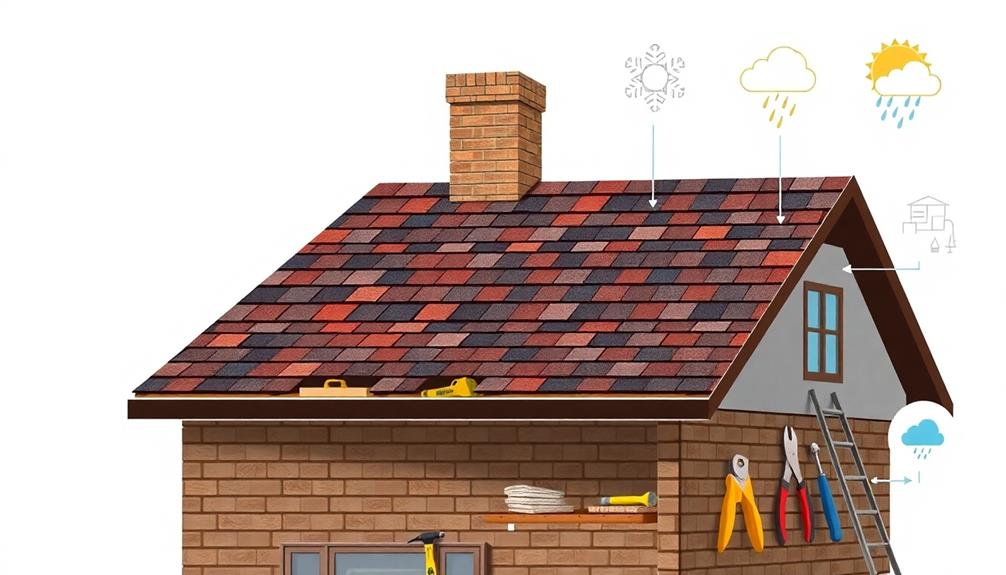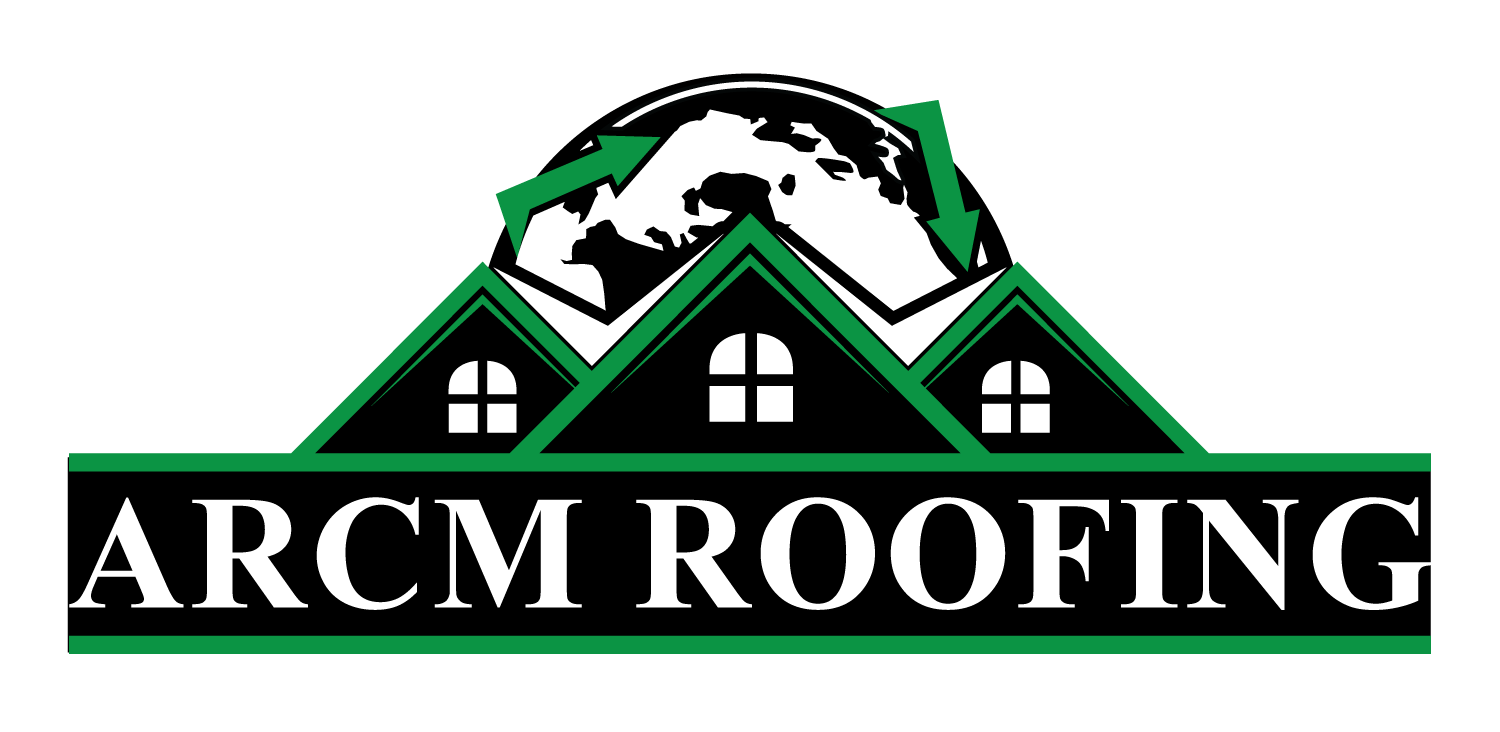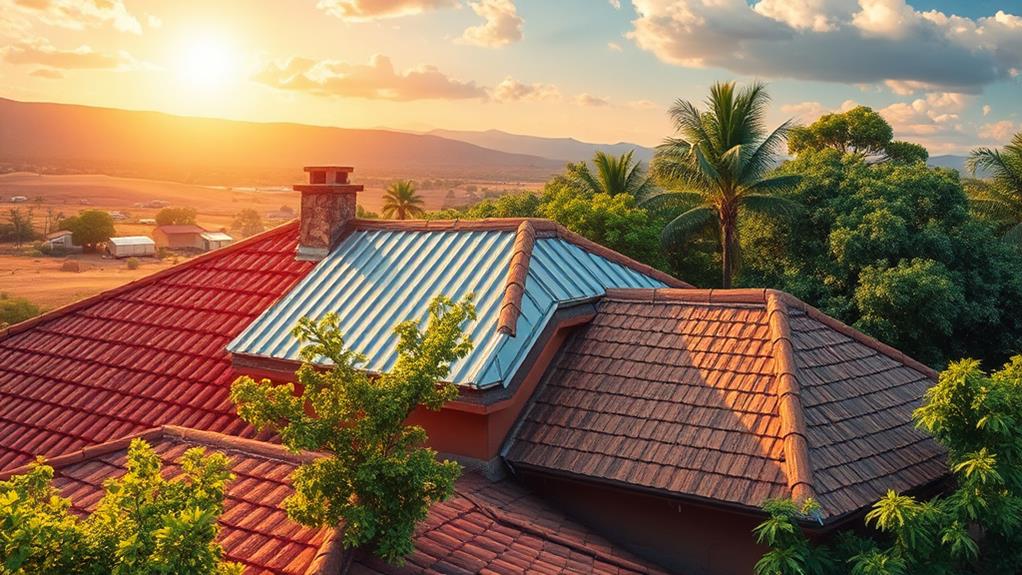The installation of a new roof involves several meticulously planned steps, beginning with understanding safety and preparation essentials like fall protection and climate-suitable materials, followed by careful removal of old roof materials to inspect the underlying structure. Next is the precise installation of components—underlayment, flashings, and shingles—to fortify the home’s protection against weather. Material selection varies by climate; reflective metal roofs suit hot environments, while impact-resistant shingles are ideal for storm-prone areas, and sturdy materials withstand snowy conditions. These considerations guarantee durability and performance, paving the way for enhanced insights on roof installation tailored to climate demands.
Roofing Highlights
- Meticulous removal of old materials and inspection of the roof deck ensure a solid foundation for the new roof installation.
- Select roofing materials based on regional climate to maximize weather protection and durability.
- Lay underlayment and install flashing precisely to prevent water intrusion and boost roof longevity.
- Choose energy-efficient materials, such as metal or reflective asphalt shingles, to lower energy costs and qualify for rebates.
- Proper insulation and ventilation enhance energy efficiency and prolong the roof’s lifespan.
Roof Installation Explained Simply

Roof installation requires meticulous planning, beginning with safety and preparation essentials that safeguard a secure working environment for professionals tasked with the job.
The process then advances to the methodical removal of old roof materials, a pivotal step in guaranteeing that the underlying structure is inspected and prepared adequately to accommodate new components.
Ultimately, the installation of new roof components completes the process, each piece carefully selected and fitted to suit the specific climatic conditions, thereby enhancing the overall durability and performance of the roof system.
Safety and Preparation Essentials
Before setting out on a roof installation project, understanding safety and preparation essentials is crucial for ensuring both worker protection and project success. A thorough grasp of the roof installation process is necessary, not only for professional roofers but also for homeowners involved in home improvement projects. Safety is paramount; employing a fall protection kit is essential in mitigating risks associated with heights during installation. This equipment is indispensable in safeguarding against potential accidents, allowing the project to proceed with confidence.
Careful preparation prevents damage, beginning with the selection of the right roofing materials tailored to combat extreme weather conditions. Such consideration not only shields against structural damage but also enhances the longevity and durability of the roof. Professional roofers meticulously plan every stage, ensuring that materials are suited to the specific climate, whether it be resisting heavy snowfall or deflecting harsh sun rays. This strategic selection is a cornerstone of successful roof installation, as it fortifies the home against nature’s elements.
Removing Old Roof Materials
A homeowner’s first step in the roof replacement process often involves the meticulous removal of old roofing materials. The process of removing old materials is integral to guaranteeing the longevity and resilience of the new roof. Professional roofing contractors possess the expertise necessary to carefully strip away old roofing without inflicting significant damage on the roof deck or underlying structure. This precision is essential, as failure to effectively remove old materials can compromise the life of your roof.
During this phase, attention is directed towards identifying any existing significant damage that may have been obscured beneath the old roof. This step ensures any unsound sections are addressed before proceeding further. The process uncovers the roof deck, allowing for a thorough inspection, which is fundamental in verifying the structural integrity before any new installation.
The task requires a keen understanding of the connection between old and new components, fostering solid belonging within the roofing system. By employing a professional roofing contractor, homeowners gain assurance that the underlying foundation is sound, facilitating a seamless shift to the subsequent installation phase. With meticulous removal, a refreshed, enduring roof becomes a reality, welcoming new horizons of protection and belonging.
Installing New Roof Components
In the pivotal phase of installing new roof components, several foundational steps guarantee the roof’s durability and effectiveness. The roofing process commences with laying the appropriate underlayment, such as self-adhesive waterproof or 15-lb. felt, which serves as a robust barrier against water intrusion between the roof deck and new shingles. This preventative measure minimizes the risk of damage, extending the roof’s lifespan and maintaining the structural integrity.
Precision in installing flashing is essential, particularly in valleys and around dormers. These critical regions are prone to water accumulation, and proper flashing ensures effective water redirection, averting potential damage. Following this, shingles are installed meticulously, adopting the manufacturer’s guidelines, notably employing 1-1/4-inch zinc-coated roofing nails for secure attachment.
The roofing process advances with the strategic placement of starter shingles, exceeding the drip edge by 1/2 inch to prevent water from seeping underneath. Furthering this professional approach, a horizontal guideline aids in the uniform alignment of subsequent shingle rows, using partial shingles to maintain consistency in reveal as you traverse across rows. Finally, secure ridge cap shingles complete the roof, harmoniously uniting new components into a resilient, aesthetically pleasing structure.
Benefits

The benefits of installing a new roof extend well beyond aesthetic improvements, as they also encompass enhanced weather protection and improved energy efficiency tailored to different climates.
High-quality materials can tremendously bolster a property’s resilience against environmental extremes, thereby decreasing the likelihood of damages and costly repairs, while concurrently boosting energy performance to yield substantial savings on utility bills.
In addition, a newly installed roof can considerably increase a property’s market value by up to 60% of the installation cost, given that it offers both a longer lifespan and improved buyer appeal.
Enhanced Weather Protection
Proper roof material selection is a vital factor in achieving enhanced weather protection, offering resilience against extreme temperatures, wind damage, and efficient water shedding. By choosing the best materials for a new roof, homeowners can ensure long-term protection against diverse weather patterns. For instance, asphalt shingles are popular for their accessibility and ability to deflect water away, thereby preventing water damage.
However, opting for the supreme roofing materials can improve these benefits significantly. Impact-resistant shingles, designed to withstand hail and heavy rain, further bolster protection against leaks and structural issues, embodying an investment that endures through harsh conditions.
Metal roofing emerges as a superior option in climates prone to high temperatures and intense sunlight, reflecting sunlight effectively and thereby regulating indoor temperatures. This material choice not only safeguards the structure but also complements roofing systems designed to keep water away by facilitating fast runoff and limiting potential water damage.
Meanwhile, integrating roof ventilation systems can further augment these protective measures over time, maintaining an ideal attic climate and mitigating risks associated with moisture buildup. With these considerations, selecting appropriate roofing materials becomes a crucial step toward maximizing the durability and performance of a new roof.
Improved Energy Efficiency
Homeowners are increasingly recognizing the substantial benefits of upgrading to energy-efficient roofing materials. This shift, integral to the Roof Replacement Process, is propelled by the tangible reductions in cooling and heating costs—up to 30%—thanks to improved energy efficiency.
When selecting the right choice of roofing materials, factors such as long-term durability and passive cooling capabilities are paramount. For instance, metal roofs reflect up to 80% of the sun’s radiant energy, thereby drastically lowering electricity bills. Moreover, asphalt shingles boasting a high Solar Reflectance Index (SRI) rating can reduce a home’s surface temperature by up to 15°F compared to standard options, further enhancing energy efficiency.
Installing the new roof with proper insulation can elevate a home’s energy efficiency by up to 50%, considerably decreasing reliance on HVAC systems. This not only assures peace of mind through lower utility costs but also positions homeowners for potential financial benefits.
Energy-efficient roofing materials can qualify for federal tax credits and utility rebates, offsetting installation expenses. Finally, incorporating ridge cap designs into the new roofing solution confirms a seamless blend of functionality and style, thereby offering homeowners a complete, energy-efficient upgrade that delivers enduring comfort and savings.
Increased Property Value
Investing in a new roof substantially bolsters a property’s market value, often enhancing resale potential by 15-20% on average, as evidenced by industry analyses. A well-executed roof replacement not only transforms a home’s external appearance but also serves as a pivotal first step in safeguarding its structural integrity for years to come.
Selecting high-quality materials such as metal or slate can further elevate a home’s value by an impressive $15,000, as studies suggest, signaling a deliberate choice towards durability and aesthetic appeal. This thoughtful investment can indeed be the next step towards a significant return should the home eventually move to market listings.
A strategically planned roofing project, executed from start to finish with meticulous attention, positions your home as more desirable in a competitive real estate environment. It’s highly recommended to ensure that the roof is both energy-efficient and visually appealing; this not only aids in reduced energy consumption but also accelerates sales.
Setting aside time for regular roof maintenance, attention to detail in material choice, and securing expert installation embodies a collective commitment to quality. This approach not only enhances your current living experience but fortifies your home’s market position in future transactions.
Extended Roof Lifespan
A roof’s contribution to property value is only as enduring as its lifespan, making longevity a critical factor in roofing projects. Choosing the right materials and guaranteeing precise installation are paramount in extending a roof’s life. High-quality options like metal and slate can endure 50-100 years, foreclosing the need for an entire roof replacement.
Proper ventilation and insulation also play instrumental roles, diminishing energy costs by up to 15% annually—an appealing advantage for the community-bound homeowner committed to sustainable living.
To maximize longevity, attention should be directed to the roof’s structural components. Utilization of starter shingles can protect edges effectively, while a drip edge ensures water is directed away, reducing the likelihood of leaks or signs of damage. Regular inspections help detect potential roof leaks or compromised areas around the ridge and hip, where damage often begins.
Prompt repairs to these areas, along with diligent maintenance practices, can prolong the roof’s life for years to come. Installing metal elements can further guard against severe weather conditions, preserving both the roof’s integrity and a sense of security within our shared neighborhoods. Such investments yield a lasting return, reinforcing the communal fabric we aspire to nurture.
Regional Climate Considerations

When selecting roofing materials, it is vital to understand the impact of regional climate conditions on a roof’s durability and function, as well as how materials can offer protection from weather variations and environmental factors. For instance, homes in regions prone to temperature extremes and significant weather events require materials that not only withstand these elements but also provide thermal resistance and protection from UV rays. The following table summarises key considerations for material choice based on climate characteristics:
| Climate Type | Key Considerations |
|---|---|
| Hot and Sunny | Reflective materials to lower energy costs |
| Heavy Snowfall | Sturdy materials for snow load resistance |
| Coastal | Impact-resistant for storm protection |
Informed choices guarantee longevity and performance while adapting to the unique challenges posed by each regional environment.
Climate Impact on Duration
The lifespan of a roof is considerably influenced by the regional climate in which it is installed, with various weather conditions imposing differing demands on roofing materials. In hot, arid climates, like the Southwest, roofs can endure up to 50 years if they incorporate proper ventilation and reflective surfaces to manage the intense heat. This first step can prevent surfaces from heating excessively, without damaging the structure.
Conversely, humid climates, like the Southeast, drastically limit roof durability—typically between 15-20 years—due to moisture that can cause damage and lead to water intrusion. Issues should be addressed as soon as possible to preserve structural integrity.
In colder regions such as the Northeast, roofs endure considerable wear from freeze-thaw cycles, often lasting 20-30 years. Maintaining the ridge and hip of the roof is critical, ensuring they are at least six inches above the rest to handle heavy snow loads that can damage if left unchecked.
Regions with temperate climates, like the Pacific Northwest, can support asphalt shingles for 30-40 years given proper maintenance. Meanwhile, areas prone to severe storms, such as the Gulf Coast, see lifespans of 15-25 years, necessitating frequent replacements to withstand high winds.
Weather-Resistant Materials
In the domain of roofing, the selection of weather-resistant materials is essential for securing a structure’s longevity and energy efficiency. For those dwelling in hot, sunny climates, metal roofs are an exemplary choice, reflecting heat and reducing cooling costs. This characteristic makes certain your roof remains a shield against excessive temperatures.
In colder regions, asphalt shingles provide reliable insulation and can withstand the burdens of heavy snowfall effectively. It is imperative that when replacing your roof, materials are removed diligently from top of the roof to the edge of the roof.
For homes situated in hot, dry areas, clay tiles excel by absorbing heat during the day and releasing it at night, thereby contributing to a cooler indoor environment.
In areas prone to severe weather or wildfires, slate roofs are celebrated for their durability and fire resistance, providing peace of mind for the rest of your home. Wood shakes and shingles, boasting superior insulation, are ideally suited for moderate climates with fluctuating temperatures and precipitation. Proper installation, such as ensuring that ridge and hip components are securely in place, must be conducted to guarantee these materials perform their utmost function, subsequently safeguarding your home’s sanctuary.
Heat and UV Protection
Amidst the challenges of regional climate considerations, understanding the impact of heat and UV exposure is crucial for selecting appropriate roofing materials. When contemplating different types of roofing for hot climates, asphalt shingles with a high solar reflective index present a practical choice. Reflecting solar radiation efficiently, these shingles help reduce heat absorption, which in turn lowers cooling costs.
Metal roofing systems are favored for their ability to reflect sunlight efficiently, making them ideal for sunny regions with high temperatures.
In areas characterized by desert or Mediterranean climates, clay tiles and concrete tiles are indispensable. These materials naturally block UV rays, contributing to cooler interior environments. Additionally, incorporating a ventilated roof design enhances heat mitigation, especially when combined with high-performance underlayments. Such configurations at the ridge and hip of roofs further facilitate efficient heat transfer management.
Considering the roof’s orientation, pitch, and overhangs also plays a pivotal role in minimizing direct sunlight exposure, making these elements essential in material selection. By prudently choosing roofing materials that align with climate needs, homeowners can foster a harmonious blend of durability and energy efficiency—fostering a sense of belonging within their community, sheltered by appropriately adapted roofs.
Roofing FAQ
How Do I Choose a Roofing Contractor for My Specific Needs?
Choosing a roofing contractor requires evaluating experience, checking references, and ensuring proper licensing and insurance. It is essential to engage someone who understands your specific needs, aligns with your values, and provides a sense of trust and community.
What Permits Are Needed for Installing a New Roof in My Area?
To install a new roof, securing a building permit from your local municipal authority is required. Permit stipulations and fees fluctuate by location. Requirements include project specifics and contractor details, ensuring regulatory compliance to avert fines or complications.
How Do Roofing Warranties Differ by Material?
Roofing warranties vary considerably by material: asphalt shingles offer 20-25 years, metal 40-50 years, wood shakes 30-50 years, while slate and tile can provide lifetime coverage. These warranties typically cover manufacturing defects, with conditions based on installation quality.
Can Roof Installations Be Financed or Require Upfront Payment?
Roof installations can often be financed through flexible options, such as loans or lines of credit, tailored to diverse financial circumstances. Additionally, arrangements may include partial upfront payments, fostering accessible solutions for homeowners committed to enhancing their property’s value.
What Are the Signs That It’s Time for a Roof Replacement, Not Just Repair?
Recognizing signs like aged shingles, water damage, moss growth, and sagging structures is vital. These indicate a need for complete roof replacement, ensuring safety and preserving your home’s integrity in the community. Prioritize professional assessments promptly.

